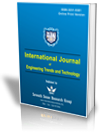Performance Prediction of Moroccan Pavements Using Artificial Neural Networks
Performance Prediction of Moroccan Pavements Using Artificial Neural Networks |
||
 |
 |
|
| © 2025 by IJETT Journal | ||
| Volume-73 Issue-4 |
||
| Year of Publication : 2025 | ||
| Author : El Abidi Oumaima, El Mkhalet Mouna, Lamdouar Nouzha, Cherradi Toufik |
||
| DOI : 10.14445/22315381/IJETT-V73I4P107 | ||
How to Cite?
El Abidi Oumaima, El Mkhalet Mouna, Lamdouar Nouzha, Cherradi Toufik, "Performance Prediction of Moroccan Pavements Using Artificial Neural Networks," International Journal of Engineering Trends and Technology, vol. 73, no. 4, pp. .70-80, 2025. Crossref, https://doi.org/10.14445/22315381/IJETT-V73I4P107
Abstract
Given its contribution to the country’s economic, social and tourist development, road infrastructure is of paramount importance to the Kingdom of Morocco. Internationally, Morocco ranks 17th in a world ranking by the International Monetary Fund (IMF), which provides a new assessment of the quality of roads across the country, with an average speed of 95 km/h. Locally, the Ministry of Equipment and Water organizes surveys to measure the ISU surface index. This index is based on the following parameters: cracking, tearing and potholes. According to the survey conducted in 2020, the results show that 62.70% of the road network is in good to fair condition, an improvement of 9.2% compared to 2012. The Kingdom demonstrates this position by improving its road infrastructure and ensuring better accessibility between major cities. In this context, improving operating conditions through maintenance projects has always been a topic of discussion among decision-makers. This disorganized maintenance generates unplanned expenses and additional costs, which can increase the cost of annual action plans. Hence, a need to rely on Pavement Management Systems (PMS) to ensure a well-balanced maintenance strategy. The objective of the study presented in this article is to simulate the performance of Moroccan pavements using artificial neural networks. Due to their reliability and high accuracy, Artificial Neural Networks are chosen to model the problem of this study. This is based on visually inspecting a section of the Moroccan national road N1 using an automated car. Through this inspection, the pathologies affecting this section are observed and measured, from which the PCI pavement condition index is calculated. Then, a model is chosen and approved by cross-validation and sensitivity study. Simulation using neural networks proves to be a good sign for developing this application to build a Moroccan PMS.
Keywords
Pavement Condition Index PCI, Performance, Distress, Artificial Neural Network, Pavement Management System (PMS).
References
[1] Abdullah M. Alsugair, and Ali A. Al-Qudrah, “Artificial Neural Network Approach for Pavement Maintenance,” Journal of Computing in Civil Engineering, vol. 12, no. 4, pp. 249-255, 1998.
[CrossRef] [Google Scholar] [Publisher Link]
[2] Dominique Bessire, “Define Performance,” Accounting Control Audit, vol. 5, no. 2, pp. 127-150, 1999.
[Google Scholar] [Publisher Link]
[3] Alessandra Bianchini, and Paola Bandini, “Prediction of Pavement Performance through Neuro-Fuzzy Reasoning,” Computer-Aided Civil and Infrastructure Engineering, vol. 25, no. 1, pp. 39-54, 2010.
[CrossRef] [Google Scholar] [Publisher Link]
[4] R. L. Lytton, “Concepts of Pavement Performance Prediction and Modelling,” 2nd North American Conference on Managing Pavements, Toronto, Ontario, Canada, vol. 2, 1987.
[Google Scholar] [Publisher Link]
[5] Serdal Terzi, “Modeling the Pavement Serviceability Ratio of Flexible Highway Pavements by Artificial Neural Networks,” Construction and Building Materials, vol. 21, no. 3, pp. 590-593, 2007.
[CrossRef] [Google Scholar] [Publisher Link]
[6] David A. Anderson, David Robert Luhr, and Charles E. Antle, Framework for Development of Performance-related Specifications for Hot-mix Asphaltic Concrete, Transportation Research Board National Research Council, pp. 1-118, 1990.
[Google Scholar] [Publisher Link]
[7] Jae-ho Choi, Teresa M. Adams, and Hussain U. Bahia, “Pavement Roughness Modeling Using Back-Propagation Neural Networks,” Computer-Aided Civil and Infrastructure Engineering, vol. 19, no. 4, pp. 295-303, 2004.
[CrossRef] [Google Scholar] [Publisher Link]
[8] Craig A. Roberts, and Nii O. Attoh-Okine, “A Comparative Analysis of Two Artificial Neural Networks Using Pavement Performance Prediction,” Computer-Aided Civil and Infrastructure Engineering, vol. 13, no. 5, pp. 339-348, 1998.
[CrossRef] [Google Scholar] [Publisher Link]
[9] Jidong Yang, “Road Crack Condition Performance Modeling Using Recurrent Markov Chains and Artificial Neural Networks,” USF Tampa Graduate, Theses, University of South Florida, pp. 1-111, 2004.
[Google Scholar] [Publisher Link]
[10] Mohamed Y. Shahin, and Starr D. Kohn, “Pavement Maintenance Management for Roads and Parking lots,” Construction Engineering Research Lab (Army) Champaign Il, Defense Technical Information Center, Report, pp. 1-236, 1981.
[Google Scholar] [Publisher Link]
[11] Habib Shahnazari et al., “Application of Soft Computing for Prediction of Pavement Condition Index,” Journal of Transportation Engineering, vol. 138, no. 12, pp. 1495-1506, 2012.
[CrossRef] [Google Scholar] [Publisher Link]
[12] Maureen Caudill, “Neural Networks Primer, Part I,” AI Expert, vol. 2, no. 12, pp. 46-52, 1987.
[Google Scholar] [Publisher Link]
[13] S. Owusu-Ababio, “Application of Neural Networks to Modeling Thick Asphalt Pavement Performance,” Artificial Intelligence and Mathematical Methods in Pavement and Geomechanical Systems, pp. 23-30, 1998.
[Google Scholar]
[14] M. Jalal and I. Floris, “Computer-Aided Prediction of Pavement Condition Index (Pci) Using Ann,” CIE47 PProceedings of The International Conference on Computers and Industrial Engineering, Lisbon, Portugal, pp. 1-8, 2017.
[Google Scholar]
[15] Jyh-Dong Lin, Jyh-Tyng Yau, and Liang-Hao Hsiao, “Correlation Analysis between International Roughness Index (IRI) and Pavement Distress by Neural Network,” 82nd Annual Meeting of the Transportation Research Board, pp. 1-21, 2003.
[Google Scholar]
[16] Yangcai Huang, and Raymond K. Moore, “Roughness Level Probability Prediction Using Artificial Neural Networks,” Transportation Research Record: Journal of the Transportation Research Board, vol. 1592, no. 1, pp. 89-97, 1997.
[CrossRef] [Google Scholar] [Publisher Link]
[17] Hasan Ziari et al., “Prediction of IRI in Short and Long Terms for Flexible Pavements: ANN and GMDH Methods,” International Journal of Pavement Engineering, vol. 17, no. 9, pp. 776-788, 2016.
[CrossRef] [Google Scholar] [Publisher Link]
[18] American Association of State Highway and Transportation Officials, Mechanistic-Empirical Pavement Design Guide: A Manual of Practice, American Association of State Highway and Transportation Officials, pp. 1-204, 2008.
[Google Scholar] [Publisher Link]
[19] Jian Liu et al., “Improving Asphalt Mix Design by Predicting Alligator Cracking and Longitudinal Cracking Based on Machine Learning and Dimensionality Reduction Techniques,” Construction and Building Materials, vol. 354, 2022.
[CrossRef] [Google Scholar] [Publisher Link]
[20] Angel Mateos et al., “Application of The Logit Model for The Analysis of Asphalt Fatigue Tests Results,” Construction and Building Materials, vol. 82, pp. 53-60, 2015.
[CrossRef] [Google Scholar] [Publisher Link]
[21] He Wang et al., “Development of Two-Dimensional Micromechanical, Viscoelastic, and Heterogeneous-Based Models for the Study of Block Cracking in Asphalt Pavements,” Construction and Building Materials, vol. 244, 2020.
[CrossRef] [Google Scholar] [Publisher Link]
[22] ASTM D6433-16, Standard Practice for Roads and Parking Lots Pavement Condition Index Surveys, ASTM International, pp. 1-48, 2018.
[CrossRef] [Google Scholar] [Publisher Link]
[23] Hamed Khosravi et al., “An Analytical-Empirical Investigation of the Bleeding Mechanism of Asphalt Mixes,” Construction and Building Materials, vol. 45, pp. 138-144, 2013.
[CrossRef] [Google Scholar] [Publisher Link]
[24] Kang Zhao et al., “Characterization of Rutting Damage Based on Two-Dimensional Image Analysis of Changes in Mesoscopic Aggregate Properties of Asphalt Mixtures,” Construction and Building Materials, vol. 428, 2024.
[CrossRef] [Google Scholar] [Publisher Link]
[25] Abdullah M. Alsugair et al., “An Artificial Neural Network Approach to Pavement Maintenance Decision Support System,” Computing in Civil Engineering, pp. 942-949, 1994.
[Google Scholar] [Publisher Link]
[26] Abdualmtalab Abdualaziz Ali, Mohamed Imbarek Esekbi, and Muftah Mohamed Sreh, “Predicting Pavement Condition Index Using Machine Learning Algorithms and Conventional Techniques,” Journal of Pure Applied Sciences, vol. 21, no. 4, pp. 304-309, 2022.
[CrossRef] [Google Scholar] [Publisher Link]
[27] Neema Jakisa Owor et al., “Image2PCI -- A Multitask Learning Framework for Estimating Pavement Condition Indices Directly from Images,” arXiv, pp. 1-21, 2023.
[CrossRef] [Google Scholar] [Publisher Link]
[28] Mohamed S. Yamany et al., “Characterizing the Performance of Interstate Flexible Pavements Using Artificial Neural Networks and Random Parameters Regression,” Journal of Infrastructure Systems, vol. 26, no. 2, pp. 1-15, 2020.
[CrossRef] [Google Scholar] [Publisher Link]
[29] Bachir Abdallah, “Morocco Ranks 17th Worldwide in the IMF Road Quality Index,” Maroc Diplomatique, 2023. [Online]. Available: https://maroc-diplomatique.net/le-maroc-se-classe-17eme-mondial-dans-lindice-de-qualite-des-routes-du-fmi/
[30] State of the Road Network, Ministry of Equipment and Water, 2025. [Online]. Available: https://www.equipement.gov.ma/Infrastructures-Routieres/Reseau-Routier-du-Royaume/Pages/Etat-du-reseau-routier.aspx

